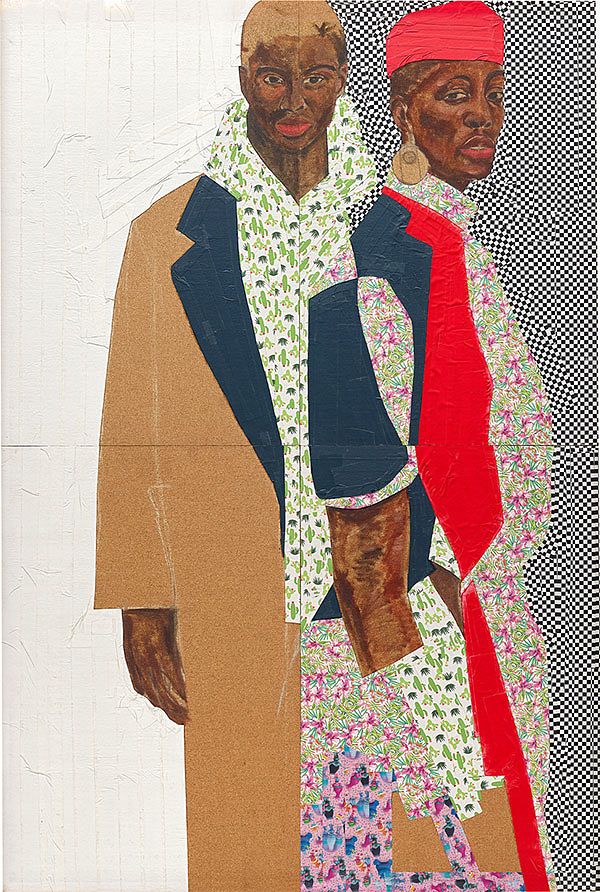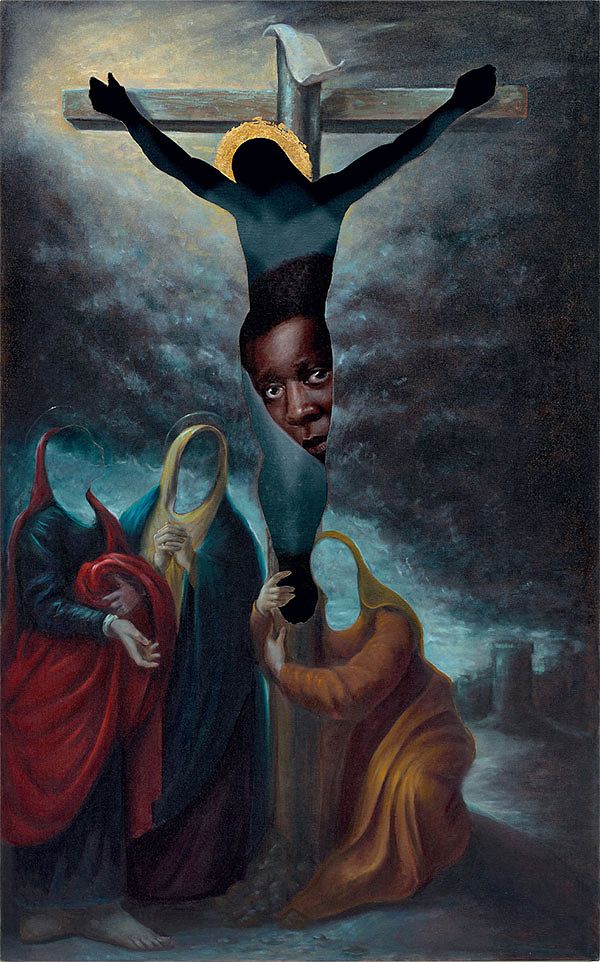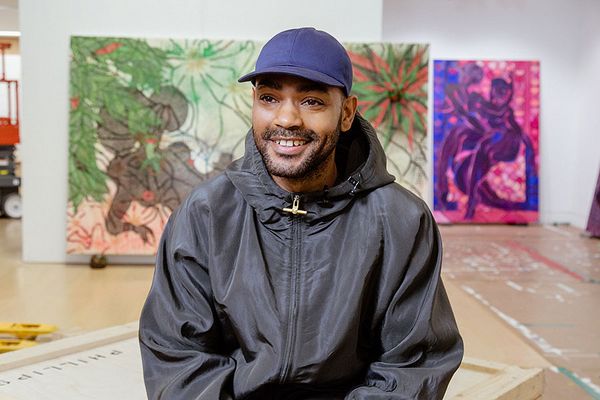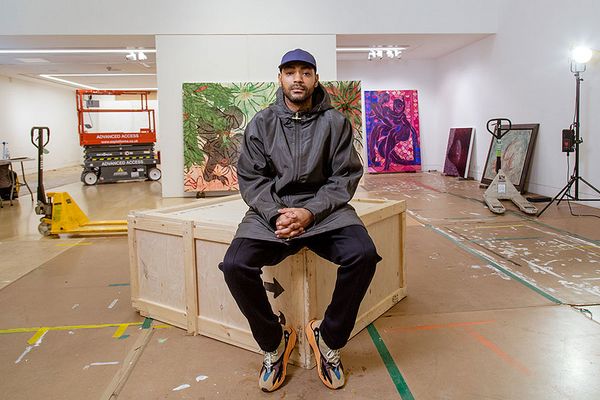Photo by Thai Hibbert, Thomas De Cruz Media. @thaimatic for @thomasdecruzmedia
Between six albums and an acting career, his CV speaks for itself. In partnership with Phillips, East London's very own Kano turns his attention to new experiences in art. Ahead of the 15 October auction in London, we discuss his chosen picks from the collection, along with how he stays inspired and what it means for artists to communicate across mediums.
PHILLIPS: Thinking of your overall practice as an artist, how does your creative process unfold? Are there any particular places you find inspiration?
KANO: With me, when it comes to, say, writing lyrics, my inspirations are drawn from personal experiences, whether they’re positive or negative — things I’ve gone through, my upbringing, the city I’m from. Those are the general themes that come across in most of my work. London features quite heavily. It always rises to the surface whenever I’m writing material. But overall, it’s that theme of day-to-day life that ends up in my music.
P: Do those ideas come up throughout the day, or do you prefer to sit down and concentrate on one thing at a time? How does it all piece together for you?
K: There will be moments throughout the day when I think of a line or an idea, but generally those experiences get absorbed and stored until I’m sitting down at home and writing, and then they come to the surface again. Creating music is a collaborative experience — I’ll be in the studio with different musicians and producers and we’ll build an instrumental track, but writing lyrics is quite a solitary experience for me. I normally take that music home and stay up late to pen all my thoughts. At times a line will pop up and I’ll work with that, but overall it’s an individual process. Music is performed in front of thousands, but often created in a room of one.
When I’m not in the process of creating material, I often don’t think about it at all. But when I’m in the mindset of making an album, I can’t think about anything else. I think about it all day in the studio, then more on the way home. Then it’s hard to sleep at night. Sometimes I’ll be struggling with a piece or a few lines that I can’t quite get, and I’ll go to bed without finishing them and wake up with the missing words, so even then, it feels like I never stopped thinking about it.
P: Was there a moment for you when you knew for certain you were an artist?
K: I was probably an artist before I knew I was. I was writing lyrics and making music around 13 or 14, but giving yourself the title of ‘artist’ feels like a jump in confidence. I was still in school, doing graphic design and other creative things, but I was still making music at home. It wasn’t until I started getting into pirate radio and performing at raves that I started feeling that confidence and acceptance from people outside my immediate area. That’s when I thought, alright, I’m an artist now. From that moment on it’s all I’ve wanted to do. I started producing my first studio album at quite a young age, which was an exciting experience. And then to follow that process with touring, traveling around the country, then outside the country doing support gigs was a mad experience for me as a young person, and to experience that with my mates was something else. It’s all something I really, really loved.

Serge Attukwei Clottey, Fashion icons, 2020-2021. 20th Century & Contemporary Art.
P: You've selected a number of artworks from the upcoming Philips Contemporary Art auction. What drew you to those works?
K: I was drawn to them for various reasons. For some it was the striking quality of their colors, for others I was interested in the techniques of the artists. But it was also about getting to know their backgrounds that drew me even closer — hearing the artists’ stories and how they represent where they’re from, or use their art to talk about issues close to them. Today was my first time seeing these works in person and really getting to get a sense of things like color and texture, depth and scale. On a phone everything’s the same size, but getting to see them up close gave me a whole new perspective with them.
P: Are there any background stories in this collection that stand out for you?
K: I’ve selected a piece by an artist named Aboudia from the Ivory Coast. The way he goes about his work is very inspired by the street, which is something I can clearly identify with. He takes inspiration from graffiti and materials you might find on the streets and then repurposes them in his work. It’s little things like that that I can identify with: taking something that’s used and finding a new use for it. To me that sounds like sampling in music. We take an old record and flip it in a different way. Sampling changes things so you’ve never seen it in this new light; you’ve never heard it in this way. That relationship really connects me to a piece of work.
I think my favorite is the Titus Kaphar piece. Before today I’d only seen it in 2D, so to experience it up close and move around it and feel the depth of the work was very cool. I’ve also come to understand more about his work and how he approaches things; the way he paints historical images and puts a Black face where it wasn’t before, yet manages to make it feel like it’s always belonged there is both powerful and inspirational for me. I’m glad there are contemporary artists out there who are really using their voices and creativity to say something meaningful. The works I’ve selected follow that idea in that the pieces seem at first to be one thing, one aspect, and then they say a bit more and make you question something. It jumps from the surface of the pieces. I’ll leave here and I'll be thinking about the same thing.

Titus Kaphar, Holy Absence II, 2014. 20th Century & Contemporary Art.
P: You've been to Philips a few times. What was it like coming for the first time, and how did you feel in the galleries?
K: Coming here for the first time was great, because at first I was on the outside looking in, literally — I wasn’t sure if you could just walk into the gallery! But knowing then that anyone could come in and see the exhibitions was great. During my first visit I came across an amazing piece by Wonder Buhle Mbambo, and when I left I looked him up on Instagram and chatted with him about his work. It’s that process of discovery that’s a continuous thing. Art is a world I’ve always respected but knew little about, so coming to Phillips and learning about the contemporary art scene and these artists has been a great experience.
P: Here’s a trade secret: If you see people drinking wine behind a large glass window, you can just walk in.
K: I saw a big guy in a suit at the door and thought, is it a guest list thing? I walked in and it was all good.

Photo by Thai Hibbert, Thomas De Cruz Media. @thaimatic for @thomasdecruzmedia
P: Thinking about the whole project, what was it that excited you about this partnership?
K: For me it was about discovering a new world, and as an artist, being able to learn about art in a different medium that creates new connections. Being able to showcase work like that is amazing. Where I come from, not a lot of people get to do that, or even think contemporary art is accessible, but it is, and it can be. It doesn’t mean you have to own it, but you can enjoy it, and that’s what I wanted to show through this process.
P: Do you collect art or anything else? What does collecting mean to you?
K: When I was young, my brother and I used to collect garage records. I don’t know where they went, but I wish I had them now. In terms of collecting art, I actually have a few pieces made by a family member — he'd never sold art before, but I saw his work and I wanted a piece, so I got it framed and up on the wall. To him it was this moment of someone else wanting to hang up his work, and that solidified the fact for him that he’s an artist. It gives that kick for him to create his next piece. It’s not always about spending millions of pounds; you can always start at any level and still get to enjoy the art.
P: Were there any moments like that for you?
K: It was when I made my first tune and pressed it onto a one-off dubplate. A DJ from my area played it on the pirate radio and it was like yeah, this is it, I’m in it. It solidified what I was doing as an artist. It was only at the local level, but it was big to me; you never forget moments like that. They help you move on to the next stage and give you that confidence.
P: How do you think artists of different mediums can inspire each other?
K: They can inspire each other a lot. You see it with film and music, how visual art and sound take inspiration from each other. It might not be immediate with contemporary art, but when you see some of these pieces, it’s very inspirational. They make you think about the process and the message and all of these things that can be used by other artists to go and create their own works. It happens in reverse, too — the artist can paint with music on in the background, or they find a song that makes them feel a certain way when working, and they then create a piece through that. It’s this back and forth, this synergy that artists share around the world. Once you’re an artist, you’re one with all of that. You’re together. We get each other. We speak the same language even though we use different techniques.
Kano is a British rapper, songwriter and actor from East Ham, London. A significant contributor to UK music, Kano is widely considered one of the pioneers of grime music and culture. Launching in 2004 with his debut single "P's and Q’s" which was an underground hit, Kano has since gone on to release six studio albums. Made in the Manor (2016) was considered one of the best albums of the year by numerous publications. It was shortlisted for the 2016 Mercury Prize and won Best Album at the 2016 MOBO Awards. Most recently, Kano’s album Hoodies All Summer (2019) was acclaimed by music critics across the board, and was shortlisted for the 2020 Mercury Prize. Alongside his music, Kano is known for his acting, most notably playing the role of Sully in Top Boy.
Discover More from 20th Century & Contemporary Art >
Recommended Reading
The Artist & The Athlete: In Conversation with Milo Matthieu and Deron Williams >
Théâtres de Mémoire: Jean Dubuffet’s Last Decades >
